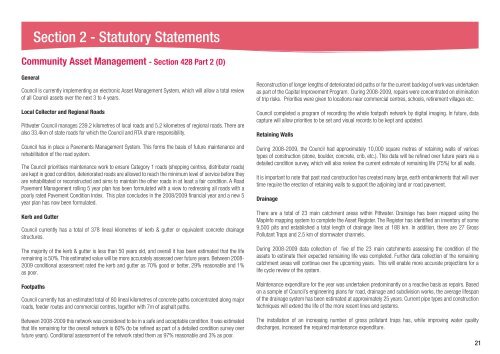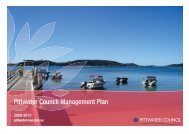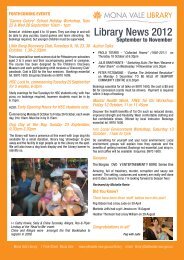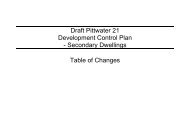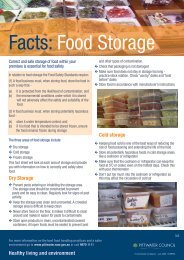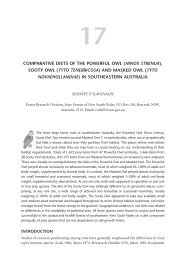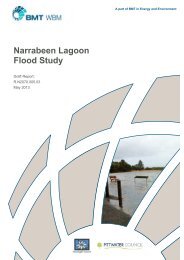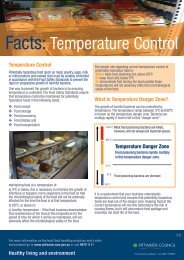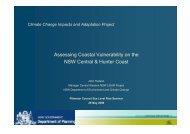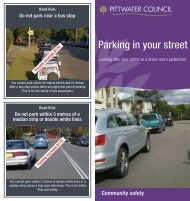Section 2 - Statutory StatementsChildren’s Services - cont.In 2009, a trial of including Year 7 students in the Vacation Care program was undertaken. It wasestablished as a result of concern expressed by a number of families who had children starting high schoolin 2009. These families were particularly concerned at the idea of leaving their 12 and 13 year old childrenat home all day while they were working. The service operated over both the Easter break and the JulySchool Holidays and at this stage is working well.<strong>Council</strong> buildings are also provided at discounted rentals to 2 community based preschool schools:Elanora Heights and Narrabeen. A further preschool, KU Avalon, has a long term lease with <strong>Council</strong> for useof the building. These preschools cater for up to 120 children per day during school terms.Additionally, the Scotland Island Child Care Centre, a community based service, operates from a <strong>Council</strong>owned building at a discounted rate. With significant assistance from <strong>Council</strong> to make changes to thebuilding, the community committee increased the days and hours of operation and developed a mother’sgroup/play group from the site. Scotland Island is an isolated community with a relatively high populationof young families. Access to the Island is only by boat and this leads to additional problems for families ofyoung children. Earlier in the year, a new Family Day Care provider was registered on the island and is nowproviding care for children from 0 – 5 years. This is the first time that any licensed care has been availablefor children under the age of 2 years on the island.<strong>Council</strong> has undertaken significant advertising to increase its Family Day Care Service. This home basedchild care service is of particular benefit to the younger children. As a result there has been an increase inregistered carers under the <strong>Pittwater</strong> Family Day Care license. The relocation of the FDC administration andplaygroups to the new Newport Community Centre has added significantly to the quality of the service. Thenew attached children’s playground, specifically designed for children under 5 years, is particularly valuedby the carers, other community based playgroups and families of young children who visit the park.The Early Childhood Health Centres (ECHC) in Avalon and Mona Vale continue to provide a hub forparents with young children. Both centres have been rebuilt in the past 7 years and from these <strong>NSW</strong> HealthDepartment delivers a health service for families with young children. Both Avalon and Mona Vale ECHCprovide a drop-in breast-feeding support service. During 2008- 2009 <strong>Council</strong> staff contacted new mother’sgroups at the ECH service at Avalon and provided support and advice.Specialist Library Services were provided for children, with library collections suitable for children aged0 to 17 years. Storytelling for pre-school children occurs three mornings each week during the schoolterm, including Book Babes for 0-2 years. New babies are presented with books on reading to children forparents and hard covered books for babies. The Children’s Librarian also operated a reading and writinggroup once per month for children in late primary school and arts and craft workshops and activities wereconducted. In July 2009, a children’s knitting group, “Knitty Gritty” was formed in conjunction with theKnitters Guild of <strong>NSW</strong>–Northern Group. Guild members are on hand to teach, guide and encourage childrento knit at no charge. This group meets fortnightly and caters for beginners to experienced knitters.Library staff liaised with local schools to organise activities with the library and regularly displayed art workfrom local high schools and primary schools. The HSC collection ontaining study guides, videos and otherinformation was available 7 days a week. The Mona Vale Library was also involved in “Inside Break”, acollaborative project between Manly, Warringah and <strong>Pittwater</strong> <strong>Council</strong>s. This included the provision of weblinks to HSC relevant support materials and a HSC lecture program of guest speakers on a range subjects.Between 2008-2009 Children in <strong>Pittwater</strong> were able to access a wide range of activities through <strong>Council</strong>’scommunity centres. Activities included kindergartens, playgroups, dance, ballet, drama, tennis, creativekindy, youth theatre, maths and English tuition, music, art, craft, social development programs, netball,soccer, martial arts, self defence programs, youth programs, physical culture, band rehearsals and danceparties. Local schools used the Community Centres for sports programs, rehearsals and performances.During school holidays a vast array of programs were available in these centres. These included tenniscamps, acting/drama programs, art and craft activities, self defence programs, performances, shows, artfestivals and workshops. The School Holiday Recreation Program is developed and published by <strong>Council</strong>each school holiday and provides information on activities offered by other organisations. These includeholiday camps provided by Camp Kedron and the <strong>NSW</strong> Academy of Sport, plus surfing clinics, multi sportcamps, gymnastics among others.The <strong>Council</strong>’s Coastal Environment Centre offered both preschool and school aged children environmentalawareness programs throughout the year.The regional playgrounds at Winnererremy Bay at Bayview and Bilarong Reserve facilities in North Narrabeenwere used extensively during the week and on weekends. During the past year shade structures have beenerected in local parks in Sector 2 and Sector 12 of the Warriewood Valley Land Release. Development ofthe district park in Sector 8 of Warriewood Valley has progressed with plans for the park and the playgroundequipment approved for construction. During the year plans for the redevelopment of the playground inDunbar Park at Avalon were finalised and construction was completed early in 2009.The recently opened Newport Community Centre has been very popular for children’s birthday partiessince opening day, with the playground being a big drawcard.20
Section 2 - Statutory StatementsCommunity Asset Management - Section 428 Part 2 (D)General<strong>Council</strong> is currently implementing an electronic Asset Management System, which will allow a total reviewof all <strong>Council</strong> assets over the next 3 to 4 years.Local Collector and Regional Roads<strong>Pittwater</strong> <strong>Council</strong> manages 239.2 kilometres of local roads and 5.2 kilometres of regional roads. There arealso 33.4km of state roads for which the <strong>Council</strong> and RTA share responsibility.<strong>Council</strong> has in place a Pavements Management System. This forms the basis of future maintenance andrehabilitation of the road system.The <strong>Council</strong> prioritises maintenance work to ensure Category 1 roads (shopping centres, distributor roads)are kept in good condition, deteriorated roads are allowed to reach the minimum level of service before theyare rehabilitated or reconstructed and aims to maintain the other roads in at least a fair condition. A RoadPavement Management rolling 5 year plan has been formulated with a view to redressing all roads with apoorly rated Pavement Condition Index. This plan concludes in the 2008/2009 financial year and a new 5year plan has now been formulated.Kerb and Gutter<strong>Council</strong> currently has a total of 378 lineal kilometres of kerb & gutter or equivalent concrete drainagestructures.The majority of the kerb & gutter is less than 50 years old, and overall it has been estimated that the liferemaining is 50%. This estimated value will be more accurately assessed over future years. Between 2008-2009 conditional assessment rated the kerb and gutter as 70% good or better, 29% reasonable and 1%as poor.Footpaths<strong>Council</strong> currently has an estimated total of 80 lineal kilometres of concrete paths concentrated along majorroads, feeder routes and commercial centres, together with 7m of asphalt paths.Between 2008-2009 this network was considered to be in a safe and acceptable condition. It was estimatedthat life remaining for the overall network is 60% (to be refined as part of a detailed condition survey overfuture years). Conditional assessment of the network rated them as 97% reasonable and 3% as poor.Reconstruction of longer lengths of deteriorated old paths or for the current backlog of work was undertakenas part of the Capital Improvement Program. During 2008-2009, repairs were concentrated on eliminationof trip risks. Priorities were given to locations near commercial centres, schools, retirement villages etc.<strong>Council</strong> completed a program of recording the whole footpath network by digital imaging. In future, datacapture will allow priorities to be set and visual records to be kept and updated.Retaining WallsDuring 2008-2009, the <strong>Council</strong> had approximately 10,000 square metres of retaining walls of varioustypes of construction (stone, boulder, concrete, crib, etc.). This data will be refined over future years via adetailed condition survey, which will also review the current estimate of remaining life (75%) for all walls.It is important to note that past road construction has created many large, earth embankments that will overtime require the erection of retaining walls to support the adjoining land or road pavement.DrainageThere are a total of 23 main catchment areas within <strong>Pittwater</strong>. Drainage has been mapped using theMapInfo mapping system to complete the Asset Register. The Register has identified an inventory of some9,500 pits and established a total length of drainage lines at 188 km. In addition, there are 27 GrossPollutant Traps and 2.5 km of stormwater channels.During 2008-2009 data collection of five of the 23 main catchments assessing the condition of theassets to estimate their expected remaining life was completed. Further data collection of the remainingcatchment areas will continue over the upcoming years. This will enable more accurate projections for alife cycle review of the system.Maintenance expenditure for the year was undertaken predominantly on a reactive basis as repairs. Basedon a sample of <strong>Council</strong>’s engineering plans for road, drainage and subdivision works, the average lifespanof the drainage system has been estimated at approximately 25 years. Current pipe types and constructiontechniques will extend the life of the more recent lines and systems.The installation of an increasing number of gross pollutant traps has, while improving water qualitydischarges, increased the required maintenance expenditure.21


